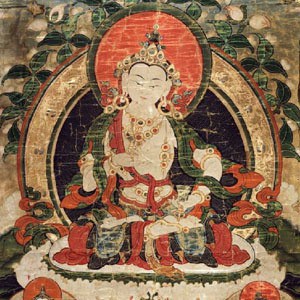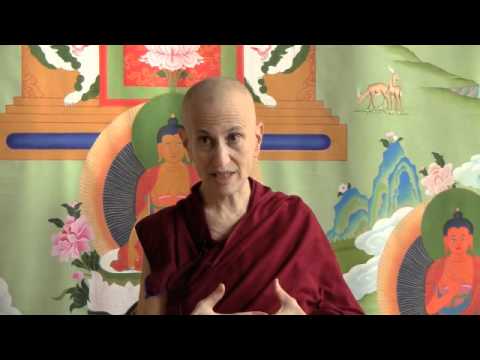Visualization in deity practice
This talk was given during the White Tara Winter Retreat at Sravasti Abbey.
- Working with the imagination, not really using the eyes
- Using imagination to develop our potential to transform ourselves
- Being creative and playful with visualization
White Tara Retreat 17: Visualization (download)
So much of our Buddhist practice relies on visualization that I wanted to talk a bit about that today. First of all, the word visualization is quite misleading and not a very good translation for what we’re actually doing. What we’re doing is working with our imagination, whereas visualization implies that we’re working with a visual image and then using our eyes. So, we’re working with our imagination. Not only are we working imagining the sight, but we’re also working with imagined touch, smell, sound, physical sensations, and feelings. It’s quite more involved than just imagined sight. We use our imagination to, in a very practical manner, to develop the potential that we all have to transform ourselves. It’s quite an important piece of our practice. The way that I think about it, and the way that we’ve been taught by Venerable Chodron, is that it’s a very creative process. Of course, imagination is creative, it makes sense. We all have the ability to use our imagination. For example if I say, “Imagine the face of your mother or your best friend,” in your mind right now an image will arise. Using imagination is very powerful—much more powerful, I think, than we realize. I’m going to take us through a very brief visualization to illustrate the power of imagination.
Close your eyes and imagine in front of you a table. On it is a cutting board and on the cutting board is a lemon: a very yellow, juicy lemon. Imagine that there’s a knife also on the table right next to the cutting board. With one of your hands take hold of the lemon. You can feel the texture of the skin, it feels quite oily. Then pick up the knife and cut into the lemon. Cut it into four sections. As you cut into the lemon, juice squirts out all over. Now set the knife down and pick up one of the sections of lemon and bring it up to your face. You can smell the lemon. Now open your mouth and take a big bite.
Our imagination can become so real that the body prepares the mouth for tartness by producing saliva to dilute the sourness. Maybe some of you had that experience; if not, at least a kind of puckering. There’s also some feeling involved. If you don’t like sour then maybe a little aversion; if you like sour a lot, maybe some attraction to it.
We can see how the body reacts to what we put into mind, what the images are: very powerful. This is with something that really we have no interest in and doesn’t have much value in our lives. It’s just an image.
If you think now over time, putting the image of the Buddha in the mind—a being that has developed all of his potential to its fullest, has none of the disturbing attitudes, no anger left, no attachment, none of those negativities, all gone! If we think about bringing to mind again and again the image of the Buddha and keeping in mind what he represents, we can see how this is a very powerful practice. It will transform our minds. When I think about imagining White Tara when we do our practice, I think of a hologram and that’s what helps my mind. Each mind is different, but for me that’s a very helpful image, a hologram, because it’s alive and it’s vibrant and it’s made of light.
The first thing we do when we’re going to start a practice, especially if it’s new for us, we have to get familiar with the Buddha figure to begin with, so we use an illustration, or maybe a thangka, or the description in the practice of what White Tara looks like. We have to get familiar with that before it can come to our mind, so we have to study it. Once we do that, then we just gently think of it and think of the points of it, all the parts of it, and let it arise in the mind. Now if we push it’s not going to come, so this isn’t something to really push hard at. Just let it arise in whatever form it arises and then just be satisfied with that.
Every meditation session is different, at least it is for me, sometimes it’s very clear and other times it’s not clear at all. That has a lot to do with the state of my mind, certainly. They also say that if we imagine a small image it’s easier to get the details, easier for it to get clear. So we just practice and we just allow what arises and make that good enough. The most important piece of this is to really feel that White Tara is actually in front of you; that this being that has perfected all qualities is in front of you. Not only are we training our ability to imagine White Tara, we’re also training our ability to imagine what it would be like to have all the qualities of the Buddha.
I invite you to get really creative with your visualization, and playful with it, and enjoy!
Venerable Thubten Jigme
Venerable Jigme met Venerable Chodron in 1998 at Cloud Mountain Retreat Center. She took refuge in 1999 and attended Dharma Friendship Foundation in Seattle. She moved to the Abbey in 2008 and took sramanerika and sikasamana vows with Venerable Chodron as her preceptor in March 2009. She received bhikshuni ordination at Fo Guang Shan in Taiwan in 2011. Before moving to Sravasti Abbey, Venerable Jigme (then Dianne Pratt) worked as a Psychiatric Nurse Practitioner in private practice in Seattle. In her career as a nurse, she worked in hospitals, clinics and educational settings. At the Abbey, Ven. Jigme is the Guest Master, manages the prison outreach program and oversees the video program.


